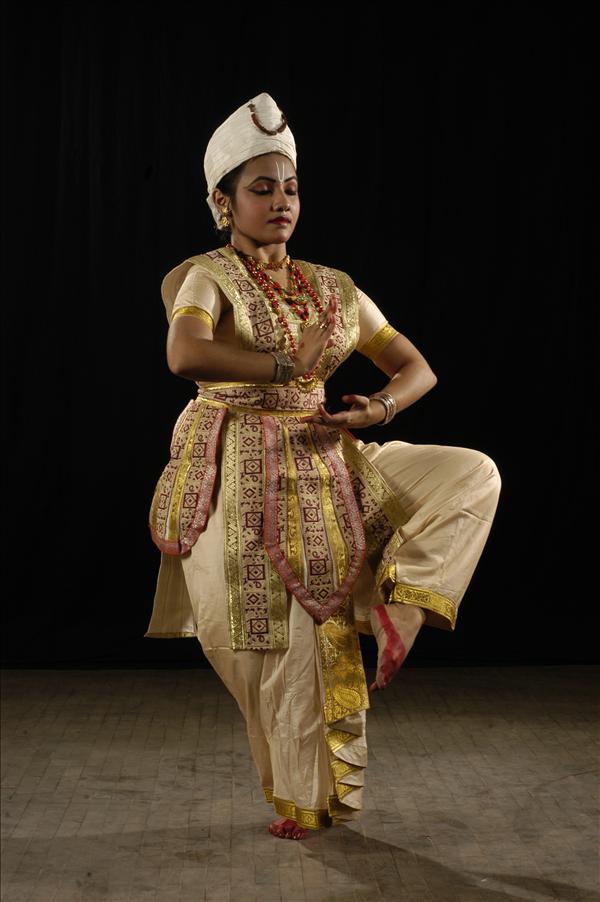 People who moan over the growing tendency of youngsters to favour Bollywood music and dance would be appeased by an equally growing number of young people pursuing traditional classical arts of India, with unmatched veneration and talent.
People who moan over the growing tendency of youngsters to favour Bollywood music and dance would be appeased by an equally growing number of young people pursuing traditional classical arts of India, with unmatched veneration and talent.
Among the latter is Anwesa Mahanta, a young woman who is known as an exponent of the ‘Sattriya’ form of dance, practiced mostly in the North East Indian State of Assam, famous for its traditions and strong links with the past.
She belongs to a family of ‘Sattras,’ also known as ‘Vaishnavas,’ who worship only Lord Vishnu in His original form and in His human incarnations of Rama and Krishna.
She is on a journey that is intrinsically divine, decorated with a number of milestones that gratify not only her parents (Professor Pradip Jyoti and mother Minati Choudhury) and Gurus but also the immediate members of her family, peers, colleagues, and most important of all, masters of Indian art.
Dedicated life
“I have dedicated my life to dancing and hope to learn more about the nuances of various styles that have been prevalent in India for thousands of years. As I read and perform more, I am overcome by elation and the urge to learn further,” she said.
There is little doubt that this youngster is a born dancer, and noticing her talent, Professor Pradip brought her under the tutelage of Indira Bora (an Award winner) and Bayanacharya Ghanakanta Bora in their native Guwahati to learn Bharata Natyam and Sattriya respectively.
Distinct differences
“While all traditional dances entail synchronisation of foot work and music, facial expressions and grace, there are some differences between Sattriya compared to South Indian dances. The costumes we use in our dance format are simpler, with white and cream colours in dominance. However, the most significant difference is that Sattriya dancers do not wear ghungroos (ankle bells) mainly because our dance style is light-footed,” she said.
Sattriya emphasises aspects of Purusha (male) and Prakriti (female), which include compositions elaborating the male and female dance numbers, she added.
Research fellow
Anwesa knew her subject well, for she is also a qualified Bharata Natyam dancer. Her research on dancing involves an in-depth study of history of Indian dancing dating back to the Vedic times. She also discusses many issues with her father, whose ancestors were Acharyas with a sound knowledge of all forms of arts.
Editor’s Note: Sattriya has remained a living tradition since it was initiated by Saint Srimanta Sankardev, the founder of Vaishnavism in Assam during the 15th Century. He created ‘Sattriya Nritya’ as an accompaniment to the ‘Ankia Naat’ (Assamese One-Act plays) which were usually performed in Sattras, named after monasteries in Assam.
 Apart from being a brilliant dancer, Anwesa is also a scholastic achiever, having obtained her graduate Honours and postgraduate degrees in English literature from Gauhati University with high distinction, ranked respectively second and third. She is currently pursuing her PhD programme in Performing Arts under the guidance of Professor Prakash Pattanaik of the Faculty of Arts at Delhi University.
Apart from being a brilliant dancer, Anwesa is also a scholastic achiever, having obtained her graduate Honours and postgraduate degrees in English literature from Gauhati University with high distinction, ranked respectively second and third. She is currently pursuing her PhD programme in Performing Arts under the guidance of Professor Prakash Pattanaik of the Faculty of Arts at Delhi University.
Her ‘Ranga Pravesham’ (first public solo performance) in 2001 was an event in itself. As well as demonstrating her proficiency in the art, Anwesa was noted as an artiste with a promise. She began performing at several dance and arts festival in several parts of India and later performed in Kuala Lumpur (Malaysia) as an empanelled artiste of the Indian Council for Cultural Relations of the Indian Government.
Seminars & Workshops
She also presented papers at national and international seminars, given lecture demonstrations and conducted workshops on Sattriya, including at Waikato University in Hamilton and Otago University in Dunedin during her recent visit.
Anwesa is passionate about ‘Kalpa,’ a not-for-profit organisation, of which she is the Joint Secretary. The Society aims to promote integration, peace, harmony and understanding among various social and ethnic groups in Assam and elsewhere.
“Dancers should understand the philosophy of the dance form in which they are associated. It is not enough for a dancer to understand the movement- but the meaning, purpose and the inherent message. Kalpa is an organisation that accords me and other artistes opportunities to promote our culture and heritage,” she said.
This youngster is aware that she has many more miles to travel on her long and divine journey but the prospects of establishing more milestones keeps her committed, dedicated and well-focused.
Among the honours and citations that she has received is the ‘Kalajeeva Puraskar’ Award presented by the School Of Theatre Arts, Visakhapatnam in Andhra Pradesh.






